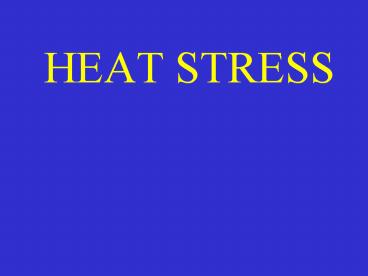HEAT STRESS - PowerPoint PPT Presentation
1 / 20
Title:
HEAT STRESS
Description:
First Aid - Cleanse area, dry thoroughly, apply calamine ... First Aid - Rest & drink plenty of water/electrolyte drink. Degree of Hazard - Moderate ... – PowerPoint PPT presentation
Number of Views:542
Avg rating:3.0/5.0
Title: HEAT STRESS
1
HEAT STRESS
2
THIS CAN BE ACCOMPLISHED THROUGH
Engineering Controls Administrative
Controls Personal Protective
Equipment Training
3
TRAINING OVERVIEW
- Heat Stress Defined
- Bodys Cooling System
- Cause, Symptoms, and First Aid
- Prevention/Controls
- Related Factors
- Assessment of Environmental Conditions
- Medical Surveillance
4
Heat Stress is the
combination of environmental and physical work
factors that constitute the total heat load
imposed on your body. Occupations at risk
laborers, military, farmers, cooks in hot
kitchens, workers in boiler rooms and factories,
seamen in engine rooms, athletes, lawn
maintenance workers, a/c repairmen, etc.
5
BODYS COOLING SYSTEM
Blood is pumped close to skin for cooling,
reduces blood going to the brain and rest of
your body As temperature rise, surface
blood vessels get bigger and pulse rate goes
up. As temperatures rise in air and
surrounding equipment, through convection,
conduction, and radiation your body gains heat
instead of losing it.
6
BODY COOLING SYSTEM - CONT.
Evaporation of sweat is how your body
cools itself. But by sweating - you
lose fluids and minerals. Most people
lose about a quart of sweat/hr in extreme heat.
This adds a strain to your circulatory
system which now has a lower amount of
blood in your body.
7
SUNBURN
Degree of Hazard - Minor to Moderate
Cause - Exposure of unprotected skin to UV light
Symptoms - First degree burns red, painful skin
Second degree blistering and/or peeling
First Aid - Skin lotions, topical anesthetics,
relocate to shade.
8
Heat Syncope
Degree of Hazard - Minimal
Cause - Pooling of blood in the legs/skin from
prolonged static posture and heat
exposure
Symptoms - Blurred vision (grey-out), fainting
(brief blackout), normal
temperature
First Aid - Lie on back in cool environment,
drink water
9
Heat Rash (Prickly Heat)
Degree of Hazard - Minimal
Cause - Constant exposure to hot/humid air
Symptoms - Pink pimples, intense itching, tingling
First Aid - Cleanse area, dry thoroughly, apply
calamine or other soothing
lotion to relieve discomfort,
could result in infection if left untreated
10
Heat Cramps
Degree of Hazard - Minor
Cause - Prolonged exposure to heat, excessive
loss of salt through profuse
sweating
Symptoms - Painful intermittent spasms of the
abdomen and other voluntary
muscles, body temperature
normal or below normal, may
occur during or after working hours
First Aid - Rest drink plenty of
water/electrolyte drink
11
Dehydration
Degree of Hazard - Moderate
Cause - Excessive fluid loss caused by sweating,
illness (vomiting or diarrhea),
alcohol consumption
Symptoms - No early symptoms, fatigue, weakness,
dry mouth
First Aid - Fluid and salt replacement (with food)
12
Heat Exhaustion
Degree of Hazard - Moderate
Cause - Physical exertion in hot environment,
dehydration Competing demands for blood flow to
skin and active muscles
Symptoms - Profuse sweating, weakness, pallor,
rapid pulse, dizziness, nausea, headache,
vomiting, rise in body temperature,
unconsciousness, skin cool/clammy with sweat
First Aid - Rest in shade/cool place drink
plenty of water.
13
Heat Stroke
Degree of Hazard - Serious
Cause - Prolonged exposure to high temperature
results in failure to regulate body
temperature
Symptoms - Dryness of mouth, sweating is
diminished or absent, skin hot and dry,skin
may be red or splotchy, high body temperature,
untreated may result in delirium, chills,
convulsions, coma and even death
First Aid - Douse body continuously with cool
liquid. Dont give person anything to
drink - they could inhale vomit into
lungs. Summon medical aid immediately!
14
Prevention
Acclimatization - Usually takes one to two
weeks Conditioning - Physically fit person has a
lower heart Lower body
temperature More efficient sweating
mechanism Hydration - Consume fluids before,
during, and after job Do not wait
until your thirsty to drink water Air
Movement - Under certain conditions
15
Prevention
Training - Self determination Workers need to
know how to recognize and
prevent heat stress Proper Clothing - Wear
light color clothing, change wet to dry
clothing when possible Eat Properly - Eat
light meals during work Save your heaviest
meal for after work
16
Related Factors - Heat Stress
Age - over 40 Gender - aerobic capacity Body
Fat - insulative barrier Drugs/Alcohol -
dehydrate the body Previous Occurrence of Heat
Stroke - heat tolerance Illness/Immunization -
affect heat tolerance
17
Higher Frequency of Injury/Illness -
Direct Causes Fogged glasses Sweat in
eyes Slippery hands Dizziness or
fainting Indirect Causes Physical
discomfort Irritability and anger
Poor judgement Diverting attention from
job Slower mental/physical job
reactions
18
Assessment of Environmental
Conditions
WBGT - Combination temperature of dry air,
relative humidity and
radiant heating. Heat Index - National Weather
Service public alert
combination of heat and humidity
19
Assessment of Environmental
Conditions
Personal Monitor - Device monitors a worker
Core
temperature and pulse rate
20
Medical Surveillance
- Evaluation of individual risk -
Preplacement/Periodic physicals - Physicians
written opinion with copy to the individual
and copy placed in medical records































